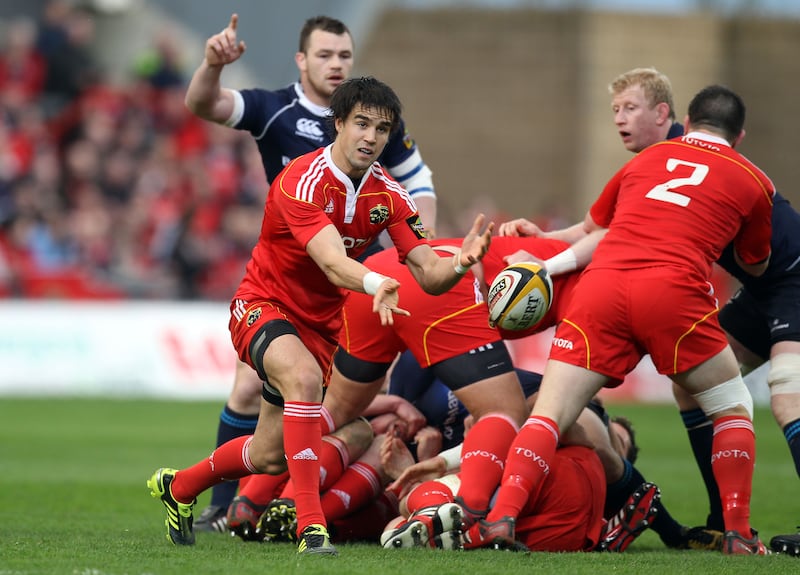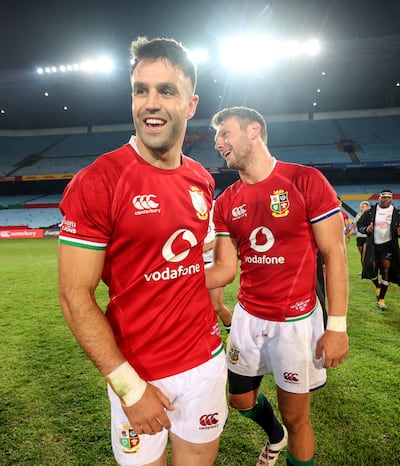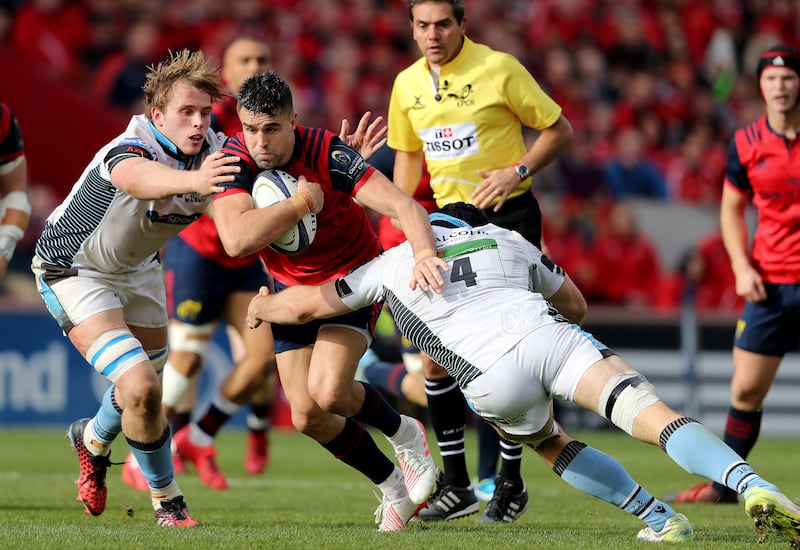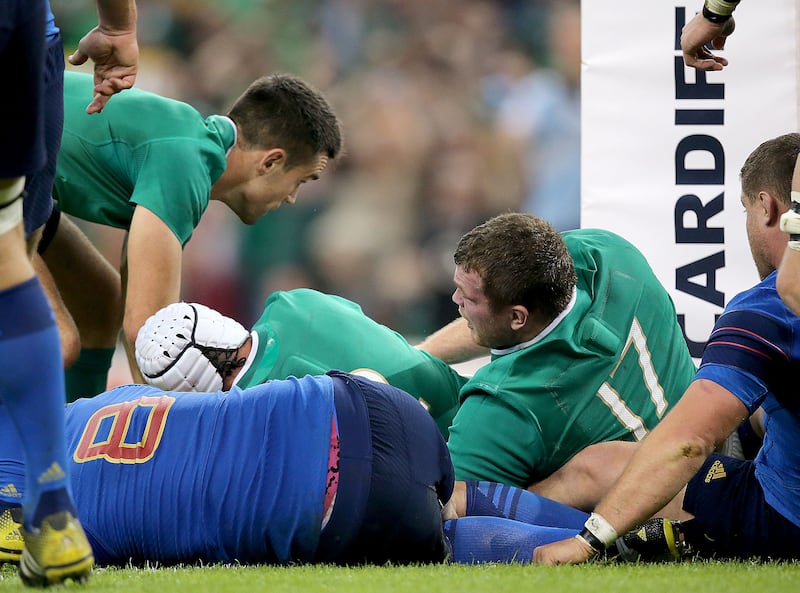You always remember the first sighting of a great player.
It was April 2nd, 2011 at Thomond Park. A full house for Munster at home to Leinster. A 21-year-old scrumhalf who was completing his third year in the province’s academy had been selected ahead of Peter Stringer, Tomás O’Leary and Duncan Williams.
The late, great Pat Geraghty, and then Munster press officer, turned to me and said: “He’ll go to the World Cup.”
Really Pat?

Conor Murray was just being given his first run of starts for Munster by Tony McGahan, but even so, in addition to Stringer and O’Leary, Eoin Reddan and Isaac Boss were also in the Irish mix. And the World Cup was the following September. Time, and the pecking order, didn’t seem to be on Murray’s side.
But McGahan kept faith in his academy scrumhalf, right up to the Magners League final win over Leinster, again in Thomond Park. Having only made his full debut against the Dragons in early March, that was Murray’s eighth start. He was the new breed of scrumhalf – young, big and strong, in the mould of Mike Phillips. He just looked a complete footballer.
Even though the provinces had no games before the World Cup, Declan Kidney named Murray as one of five scrumhalves in an expanded training squad along with Stringer, O’Leary, Reddan and Boss. Murray still seemed to be fifth in the pecking order.
In Ireland’s first warm-up game, a 10-6 loss away to Scotland, O’Leary started with Boss on the bench. A week later, Murray was named on the bench against France in Bordeaux, replacing Reddan on the hour. He played as if to the manor born, like a player with a Test match mentality, unfazed and assured in all he did.
The following Thursday, Murray replaced Boss for the last 33 minutes as an Ireland XV beat Connacht 38-3 in Donnybrook, while O’Leary started and Reddan finished the 26-22 home defeat by France two days before the squad was announced.
Reddan, Boss and Murray were the three scrumhalves named, and Murray finished it as first-choice when starting the quarter-final against Wales.
[ Johnny Sexton: ‘It’s mad to think I’m still going’Opens in new window ]
Even though he remained first-choice under Kidney for the next two seasons, there’d be a similar process come the 2013 British & Irish Lions tour to Australia. Murray went out as apparent third choice behind Phillips and Ben Youngs, which came to pass in the First Test.
But he was promoted to the bench for the next two Tests, replacing Phillips for the final half-hour in the decider with the game in the balance at 22-16 to the Lions. Three unanswered tries saw the Lions clinch a series win with a 41-16 victory, and had there been another Test one ventures that Murray would have started it.
Admittedly, Joe Schmidt initially seemed to have a preference for Reddan, but gradually Murray became the main man, with his superb box-kicking becoming a staple diet in Ireland’s effective exit strategy and aerial game generally.
Yet there has been so much more to Murray’s game than that. As well as a long pass which was quick through the air, there has been his carrying game and tries, his under-appreciated strength around the fringes and superb defence across the line, his ability to execute his skill set and make the right decisions in broken play.
There’s also been his role as an emergency goal-kicker. Remember that nonchalantly-taken penalty in Chicago against the All Blacks as Johnny Sexton was being treated and replaced to give Ireland a two-score lead nearing the hour? It nearly cleared the stadium roof.
Over a period of around five seasons, Murray’s performances probably established him as Ireland’s greatest scrumhalf and for a period in the 2015-16 and 2016-17 seasons as the best scrumhalf in the world, even eclipsing the great Aaron Smith when an ever-present in that drawn 2017 Lions series.
Murray deserved to be shortlisted for World Player of the Year in either 2017 or 2018, and had it not been for the neck injury which sidelined him for the first few months of the 2018-19 season, he would have deserved to be nominated in addition to Sexton, the eventual winner.
Compared to Smith (21 tries in 112 Tests), Murray has scored 15 tries in 99 Tests, but since returning from that neck injury in 2018 he lost confidence in his ability to make a break.
In his last 32 Tests over three seasons before that injury, he scored nine tries. In the 32 since, he has scored three, and only one in his last 28 appearances for Ireland.
Admittedly, Murray started all of those 32 Tests before the injury, whereas he’s been on the bench and restricted to cameo roles in starting only one of his 10 Tests since the win over England at the end of the 2021 Six Nations.
He would be named as Alun Wyn Jones’s replacement as Lions captain, if only temporarily.

Many players might have struggled with the readjustments he’s had to make since then. Relegated to the bench for the first and third Lions Tests, Murray has since been effectively supplanted by Jamison Gibson-Park in this Irish team.
Yet à la Peter O’Mahony and Keith Earls, Murray has embraced the Andy Farrell methodology and culture. That’s not surprising, for as well as being easy-going, pleasant and respectful, he’s also ego-free.
And while he may not be quite the dominating, match-winning force of his pomp, Murray still has much to offer. There was something reassuring in seeing him bring his big-game experience and temperament to bear in the three Tests in New Zealand, and particularly when Ireland were losing their grip against 14-man England in Twickenham last season.
There will be those who interpret his recall as a signal that today there’ll be a box-kicking fest. Yet when Faf de Klerk did this in the last World Cup, he was one of the darlings of the tournament. Whatever the team’s tactics, Murray will employ them. Against Leinster, he box-kicked once. He also bookended the first-half in that game by saving two tries when holding Jason Jenkins and Dan Sheehan up over the line.
[ Gerry Thornley: Munster need to circle the wagons as Ulster game looms largeOpens in new window ]
It’s fitting that he starts on his 100th cap, rather than as a replacement, as happened to Ronan O’Gara when coming on for the last 14 minutes in the 23-21 defeat by South Africa in November 2010.
“I am in awe of these people,” Farrell said on Thursday in light of Murray becoming Ireland’s eighth centurion. “It’s pretty special because we all know that to be able to get to that type of career, what it takes.
“Whether you are a coach or a player you see all the ups and downs and all the pressures that come in from all sorts of directions and you see everyone wants to move on to what they perceive to be the next best thing. Somebody who stands up to be counted time and time again, to get to a point like that, I’m in awe of it because the hardest thing is to stay at the top.

“Of course, there are ups and downs but the biggest compliment I could pay Conor – he’s a legend of Irish rugby and his abilities are second to none – is that he is a top, top class bloke. I don’t know anyone who has a bad word to say about him.
“We are all obsessed with rugby but when it comes to how he has managed himself throughout his career, and there are big things still to come . . . he is classed as a fantastic human being by his peers.”
Some 11 years on from that assured debut in Bordeaux, Murray has 99 caps to his name and has his eyes on his fourth World Cup. In addition to his 99 caps for Ireland, he has played eight Tests for the Lions, and the last Irish Lions’ scrumhalf was John Robbie in 1980 in South Africa.
Stringer and Reddan might feel that they were better than some of the scrumhalves chosen ahead of them, but Murray is the only Irish scrumhalf to have played for the Lions in 10 tours over the last 42 years.
This is a day to celebrate a legend, a proud day for his family and friends, and for all those who helped him along the way, be it John Broderick and Brian O’Donoghue at St Munchin’s, those in Young Munster and Garryowen, Greg Oliver in Murray’s Munster academy days, and thereafter. A huge number of people will be proud of Murray’s landmark today.
He’ll probably be replaced by Gibson-Park around the hour mark but it’s also a huge game for Murray, a chance to underline his continuing value.
“We have had a couple of conversations that meant a lot to me and to him,” said Farrell on Thursday.
“And to fast forward to the point where you say in regard to Jamison taking over, that’s never the case with anyone. Just because something happens doesn’t mean something else can’t happen the following week after that. It is how you apply yourself and how you take your chance when your chance comes.
“I know his game and what he can do and what he is like right at the top when he is at his best and I’m excited to see that on Saturday.”
On this day of all Murray’s days, a win would be fitting.
FOUR OF MURRAY’S BEST
September 17th, 2011. World Cup, Eden Park. Ireland 15 Australia 6: Murray came on before the hour mark and near the end and sidestepped Drew Mitchell before scoring in the corner. Alas Bryce Lawrence penalised Rory Best for an illegal turnvoer. “It was an unbelievable piece of skill,” recalls Paul O’Connell. “As an Irishman I was saying ‘this is great, we’ve an unbelievable player but thank God he’s a Munsterman as well’. That always sticks out for me. We watched the highlight reel of some of his stuff last night and that didn’t feature. If the try had been allowed it would have been a magic moment.” Murray came of age that night.
October 11th, 2015. World Cup, Millennium Stadium. Ireland 24 France 9: An ugly French team playing ugly French rugby exacted a heavy toll, with Johnny Sexton dumped out of the tournament by Louis Picamoles’ late hit in the 25th minute, and O’Connell and Peter O’Mahony followed suit by the hour mark. Amid the carnage, Murray’s assuredness became even more influential. In the 50th minute he picked out Rob Kearney for a good finish to push Ireland 14-6 ahead and then, at 14-9 in the 72nd minute, after Best had been held up inches short Murray had the presence of mind to ground the ball against the base of the upright to seal this pool decider.

November 5th, 2016. Soldier’s Field, Chicago. Ireland 40 New Zealand 29: Murray was at the heart of this epic and historic first win over the All Blacks at the 29th attempt. Spotting space behind, a high point was his dummy to Aaron Smith at a ruck inside the AB 22 before accelerating through and veering inside Beauden Barrett to score Ireland’s third try. Near the hour he effortlessly landed a 40-metre penalty and hounded Julien Savea into touch from Simon Zebo’s kick ahead in the build-up to Robbie Henshaw’s match-clinching try. The IT wrote: “Murray dominated the game more than any other player, and with this performance cemented his status as assuredly Ireland’s greatest ever scrum-half.”
March 17th, 2018. Grand Slam coronation, Twickenham. England 15 Ireland 24: Murray’s role in the 42-phase ‘le drop’ on the opening day in Paris is generally overlooked. But he passed accurately off every ruck bar two – once securing the ball with a clear-out and once making a carry – including, of course, the perfect last pass to Sexton at the end of a punishing shift. Tries followed against Italy and Scotland, and on an icily cold St Patrick’s Day, Murray’s blindside snipe and pass to Jacob Stockdale led to the latter’s try in first-half overtime for a 21-5 half-time lead. Cometh the hour Murray again slotted a penalty to give Ireland an unassailable 24-5 lead.











